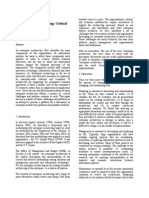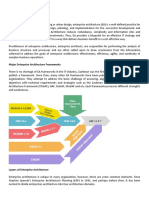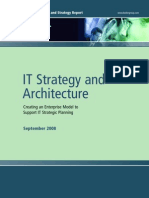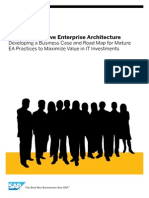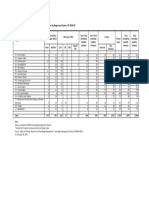Enterprise Architecture
Enterprise Architecture
Uploaded by
ElisielMc MartinezCopyright:
Available Formats
Enterprise Architecture
Enterprise Architecture
Uploaded by
ElisielMc MartinezCopyright
Available Formats
Share this document
Did you find this document useful?
Is this content inappropriate?
Copyright:
Available Formats
Enterprise Architecture
Enterprise Architecture
Uploaded by
ElisielMc MartinezCopyright:
Available Formats
As
described in American Na.onal Standards Ins.tute/Ins.tute of Electrical and Electronics Engineers (ANSI/IEEE) Std 1471-2000, an architecture is "the fundamental organiza.on of a system, embodied in its components, their rela.onships to each other and the environment, and the principles governing its design and evolu.on."
The goal of enterprise architecture is to promote alignment, standardiza.on, reuse of exis.ng IT assets, and the sharing of common methods for project management and soLware development across the organiza.on. The end result, theore.cally, is that the enterprise architecture will make IT cheaper, more strategic, and more responsive.
The purpose of enterprise architecture is to create a map of IT assets and business processes and a set of governance principles that drive an ongoing discussion about business strategy and how it can be expressed through IT.
Frameworks contain four basic domains, as follows: Business architecture: documenta.on that outlines the company's most important business processes; Informa=on architecture: iden.es where important blocks of informa.on, such as a customer record, are kept and how one typically accesses them; Applica=on system architecture: a map of the rela.onships of soLware applica.ons to one another; and The infrastructure technology architecture: a blueprint for the gamut of hardware, storage systems, and networks. The business architecture is the most cri.cal, but also the most dicult to implement, according to industry prac..oners.
Enterprise Architecture (EA) Frameworks (par=al list) 1. 1. Zachman Enterprise Architecture Framework (ZIFA) 2. The Open Group Architecture Framework (TOGAF) ) 3. Extended Enterprise Architecture Framework (E2AF) ) 4. Enterprise Architecture Planning (EAP) ) 5. Federal Enterprise Architecture Framework (FEAF) ) 6. Treasury Enterprise Architecture Framework (TEAF) ) 7. Integrated Architecture Framework (IAF) ) 8. Joint Technical Architecture (JTA) ) 9. Command, Control, Communica.ons, Computers, Intelligence, Surveillance, and Reconnaissance (C4ISR) and DoD Architecture Framework (DoDAF) ) 10. Department of Defense Technical Reference Model (DoD TRM) ) 11. Technical Architecture Framework for Informa.on Management (TAFIM) ) 12. Computer Integrated Manufacturing Open System Architecture (CIMOSA) ) 13. Purdue Enterprise Reference Architecture (PERA) ) 14. Standards and Architecture for eGovernment Applica.ons (SAGA) ) 15. European Union-IDABC & European Interoperability Framework) 16. ISO/IEC 14252 (IEEE Std 1003.0) ) 17. IEEE Std 1471-2000 IEEE Recommended Prac.ce for Architectural Descrip.on Fundamentally, all models seek in some way to make use of the concept of a generic service/object- oriented architecture
Macro view of the environment and of enterprise architecture.
Maturity of enterprise architecture development at a rm.
Necessity of enterprise architecture as environment grows more complex.
Some basic events that trigger a refresh of an enterprise architecture.
Any enterprise architecture must be seen (designed, delivered, and internally sold) as a deliverable product, something that can be "touched and used" not just an abstract conceptualiza=on. In the IT context, an architecture needs to be perceived (seen) by users and stakeholders almost like another IT system applica.on: it must have inputs, outputs, func=onality, built-in data, etc. A simple conceptualiza=on is dicult to be seen as adding value.
Enterprise architecture model, also showing architecture ar=facts.
Business Func=on: This is a descrip.on of all business elements and structures that are covered by the enterprise. Business Architecture: An architectural formula.on of the Business Func.on. Informa=on Func=on: This is a comprehensive iden.ca.on of the data, the data ows, and the data interrela.ons required to support the Business Func.on. The iden.ca.on, systema.za.on, categoriza.on, and inventory/storage of informa.on are always necessary to run a business, but these are essen.al if the data-handling func.ons are to be automated. Informa=on Architecture: An architectural formula.on of the Informa.on Func.on via a data model. (Systems/Applica=on) Solu=on Func=on: This is the func.on that aims at delivering/supplying computerized IT systems required to support the plethora of specic func.ons needed by the Business Func.on. (Systems/Applica=on) Solu=on Architecture: An architectural deni.on of the (Systems/ Applica.on) Solu.on Func.on. Technology Infrastructure Func=on: The complete technology environment required to support the Informa.on Func.on and the (Systems/Applica.on) Solu.on Func.on. Technology Infrastructure Architecture: An architectural formula.on (descrip.on) of the Technology Infrastructure Func.on.
A layered model of the enterprise architecture.
You might also like
- Brilliant Activities For Reading Comprehension Year 2 1nbsped 9780857474964 9780857474834 CompressDocument122 pagesBrilliant Activities For Reading Comprehension Year 2 1nbsped 9780857474964 9780857474834 CompressmherguegarNo ratings yet
- Enterprise Architecture PlanningDocument9 pagesEnterprise Architecture PlanningRahul V SNo ratings yet
- Enterprise Architecture Visualization Tool Survey 2014Document417 pagesEnterprise Architecture Visualization Tool Survey 2014Sascha RothNo ratings yet
- Enterprise Architecture in The Singapore GovernmentDocument15 pagesEnterprise Architecture in The Singapore GovernmentwanmuswymyNo ratings yet
- TOGAF Per ADM Phase DeliverablesDocument1 pageTOGAF Per ADM Phase DeliverablesHasti YektaNo ratings yet
- Business Analysis and Requirements Engineering - The Same, Only DifferentDocument3 pagesBusiness Analysis and Requirements Engineering - The Same, Only DifferentBoris HuertaNo ratings yet
- BrochureDocument3 pagesBrochureMarjorie BrookNo ratings yet
- Selecting An Enterprise Architecture Framework - 02!20!12v1.1Document15 pagesSelecting An Enterprise Architecture Framework - 02!20!12v1.1casakaNo ratings yet
- OverviewDocument7 pagesOverviewsaran190390No ratings yet
- Enterprise Architecting: Critical ProblemsDocument10 pagesEnterprise Architecting: Critical ProblemsNavyaNo ratings yet
- PPT9-TOPIK9-R0-Method and Framework of EADocument61 pagesPPT9-TOPIK9-R0-Method and Framework of EANatasha AlyaaNo ratings yet
- 2 Introduction TOGAF and Phase Requirements ManagementDocument81 pages2 Introduction TOGAF and Phase Requirements ManagementSILVERNo ratings yet
- IT 305 What Is Enterprise ArchitectureDocument10 pagesIT 305 What Is Enterprise ArchitectureMaria May OcheaNo ratings yet
- World Class Ea Governors Approach To Developing and Exercising An Enterprise Architecture Governance Capability w178Document51 pagesWorld Class Ea Governors Approach To Developing and Exercising An Enterprise Architecture Governance Capability w178Faqih ZulfikarNo ratings yet
- SABSA White PaperDocument17 pagesSABSA White PaperpikamauNo ratings yet
- Cloud Computing Requires Enterprise Architecture and TOGAF 9 Can Show The WayDocument54 pagesCloud Computing Requires Enterprise Architecture and TOGAF 9 Can Show The WayAnonymous PDGLsjN1Q5No ratings yet
- Evaluating and Refining The Enterprise ArchitectuDocument15 pagesEvaluating and Refining The Enterprise ArchitectuSudhakar jhaNo ratings yet
- Course Code and Title: ENTERPRISE ARCHITECTURE Lesson Number: Lesson 1 (Week 1) Topic: Introduction To Enterprise ArchitectureDocument28 pagesCourse Code and Title: ENTERPRISE ARCHITECTURE Lesson Number: Lesson 1 (Week 1) Topic: Introduction To Enterprise ArchitectureAllysa Cebeda PascasioNo ratings yet
- TOGAF Certified E2Document12 pagesTOGAF Certified E2mahesh881245No ratings yet
- Enterprise Architecture Tool Selection Guide v4.2Document20 pagesEnterprise Architecture Tool Selection Guide v4.2api-19912289No ratings yet
- Chapter 01 - Introduction To EaDocument18 pagesChapter 01 - Introduction To EaMrz RostanNo ratings yet
- Final Zachman and TOGAF Enterprise FrameworkDocument12 pagesFinal Zachman and TOGAF Enterprise FrameworkMati Chala100% (1)
- Topic: Business Process Management (BPM) Management & StrategyDocument6 pagesTopic: Business Process Management (BPM) Management & StrategyTesfayé HailuNo ratings yet
- Business Case For EA - IserverDocument23 pagesBusiness Case For EA - IserverNishant KulshresthaNo ratings yet
- The Open Group Architecture FrameworkDocument4 pagesThe Open Group Architecture FrameworkbalajismithNo ratings yet
- EAAF - Enterprise Architecture Assessment Framework v3.1Document56 pagesEAAF - Enterprise Architecture Assessment Framework v3.1willie vergaraNo ratings yet
- Enterprise Architecture Tool Selection Guide v50Document26 pagesEnterprise Architecture Tool Selection Guide v50wongwswNo ratings yet
- Brkcol 1985Document93 pagesBrkcol 1985acehussainNo ratings yet
- Enterprise Architecture Metrics A Clear and Concise ReferenceFrom EverandEnterprise Architecture Metrics A Clear and Concise ReferenceNo ratings yet
- AGA EA Principles - V1.1 0Document26 pagesAGA EA Principles - V1.1 0rony leeNo ratings yet
- Developing Enterprise ArchitectsDocument12 pagesDeveloping Enterprise ArchitectskikinjoNo ratings yet
- The Value of Enterprise ArchitectureDocument28 pagesThe Value of Enterprise ArchitecturePeter Evans-GreenwoodNo ratings yet
- Enterprise Architecture: A Maturity Model Based On TOGAF ADMDocument11 pagesEnterprise Architecture: A Maturity Model Based On TOGAF ADMMukendi EmmanuelNo ratings yet
- TOGAF V91 M2 TOGAF9 Components PDFDocument13 pagesTOGAF V91 M2 TOGAF9 Components PDFmurali_pmp1766No ratings yet
- FLR005 TOGAF AcceleratorDocument2 pagesFLR005 TOGAF Acceleratorprince2venkatNo ratings yet
- Enterprise Architecture1Document46 pagesEnterprise Architecture1Prasun Roy ChowdhuryNo ratings yet
- IT Strategy and Architecture ManagementDocument7 pagesIT Strategy and Architecture ManagementeSleuthNo ratings yet
- EA Principles SampleDocument18 pagesEA Principles SampleAnime PopNo ratings yet
- TOGAF 9 and Archimate 2.0 For Aligning SOA With Business Strategies and CapabilitiesDocument44 pagesTOGAF 9 and Archimate 2.0 For Aligning SOA With Business Strategies and CapabilitiesArgha RahaNo ratings yet
- TOGAF V91 M0 Course IntroDocument18 pagesTOGAF V91 M0 Course Introswapnil_bankarNo ratings yet
- DeloitteDocument4 pagesDeloitteميلاد نوروزي رهبرNo ratings yet
- Togaf Open Group Business ScenarioDocument40 pagesTogaf Open Group Business Scenariohmh97No ratings yet
- Developing Business Architecture With TOGAF With TOGAF: Building Business Capability 2013 Las Vegas, NVDocument23 pagesDeveloping Business Architecture With TOGAF With TOGAF: Building Business Capability 2013 Las Vegas, NVadvifulNo ratings yet
- TOGAF 9 in Pictures (Iserve 2010) PDFDocument35 pagesTOGAF 9 in Pictures (Iserve 2010) PDFzouppaNo ratings yet
- Extended Enterprise Architecture Maturity Model Guide v2Document8 pagesExtended Enterprise Architecture Maturity Model Guide v2amunoz81No ratings yet
- 1 Intro To Enterprise ArchitectureDocument76 pages1 Intro To Enterprise ArchitecturechachamohsinNo ratings yet
- Digital Govt Architecture Publication Compilation 2022Document299 pagesDigital Govt Architecture Publication Compilation 2022Mynameis lakhanNo ratings yet
- Key Terminology of The TOGAF 9 Standard PDFDocument8 pagesKey Terminology of The TOGAF 9 Standard PDFraghuNo ratings yet
- Enterprise SOA Reference ArchitectureDocument20 pagesEnterprise SOA Reference ArchitectureTushar100% (33)
- TOGAF Poster Series # 40 Architecture Capability Framework (Goodelearning)Document1 pageTOGAF Poster Series # 40 Architecture Capability Framework (Goodelearning)pranavvikasNo ratings yet
- Building Effective Enterprise Architecture (EN) PDFDocument12 pagesBuilding Effective Enterprise Architecture (EN) PDFmarcelojscostaNo ratings yet
- Archimate BloomDocument54 pagesArchimate BloomJuan PerézNo ratings yet
- Qrs Togaf 8-9 Study GuideDocument126 pagesQrs Togaf 8-9 Study Guideritesh_aladdinNo ratings yet
- Togaf 9 NotesDocument18 pagesTogaf 9 Notesmohammedomar1974No ratings yet
- Design of Architecture Enterprise Model Information System Academic and Student Administration Bureau Using Togaf AdmDocument9 pagesDesign of Architecture Enterprise Model Information System Academic and Student Administration Bureau Using Togaf AdmMonik Ragil YulindaNo ratings yet
- TOGAF Poster # 123 - Managing Architecture Views and Viewpoints (Goodelearning)Document1 pageTOGAF Poster # 123 - Managing Architecture Views and Viewpoints (Goodelearning)pranavvikasNo ratings yet
- 2 Togaf 9 1 Enterprise Architecture Framework Overview m2 SlidesDocument57 pages2 Togaf 9 1 Enterprise Architecture Framework Overview m2 SlidesMounir Ben MohamedNo ratings yet
- ORACLE - Overview of IT Strategies From Oracle - OOW Presentation PDFDocument47 pagesORACLE - Overview of IT Strategies From Oracle - OOW Presentation PDFHarumNo ratings yet
- Enterprise Architecture Literature ReviewDocument20 pagesEnterprise Architecture Literature ReviewKing Gorazo100% (1)
- It Strategy: The Definitive Guide To Developing An IT Strategy and RoadmapDocument19 pagesIt Strategy: The Definitive Guide To Developing An IT Strategy and RoadmapSadick100% (1)
- Enterprise Architecture EA A Complete Guide - 2019 EditionFrom EverandEnterprise Architecture EA A Complete Guide - 2019 EditionNo ratings yet
- Enterprise Architecture Body of Knowledge A Complete Guide - 2019 EditionFrom EverandEnterprise Architecture Body of Knowledge A Complete Guide - 2019 EditionNo ratings yet
- Resume 1Document2 pagesResume 1api-439701391No ratings yet
- Lesson PlanDocument7 pagesLesson PlanMa Nida BaldelobarNo ratings yet
- Gordons Ass ToolDocument2 pagesGordons Ass ToolMary Les RNNo ratings yet
- Q4 HE Cookery 7 8 Week1Document4 pagesQ4 HE Cookery 7 8 Week1Alexander Garcia100% (1)
- Nouns 7Document2 pagesNouns 7Rouble PaulNo ratings yet
- The Status of The Philippine National PoliceDocument34 pagesThe Status of The Philippine National Policejayruleatkins60% (15)
- Homework 1 A Simpler CookieDocument6 pagesHomework 1 A Simpler Cookieafeudgbfr100% (1)
- Forms of MILDocument16 pagesForms of MILVictor RosalesNo ratings yet
- PL2303 Windows Driver User Manual v1.7.0Document20 pagesPL2303 Windows Driver User Manual v1.7.0Tony FlemingNo ratings yet
- Prevention of Childhood Obesity: A Review of Systematic ReviewsDocument38 pagesPrevention of Childhood Obesity: A Review of Systematic ReviewsalimohhNo ratings yet
- Understanding Error Propagation in Deep Learning Neural Network (DNN) Accelerators and ApplicationsDocument12 pagesUnderstanding Error Propagation in Deep Learning Neural Network (DNN) Accelerators and ApplicationsĐăng Nguyên Trịnh VũNo ratings yet
- Sample Doc File 500kbDocument83 pagesSample Doc File 500kbMarius SiminiceanuNo ratings yet
- Script SSCT Retreat TeambuildingDocument10 pagesScript SSCT Retreat TeambuildingEDMAR POLVOROZA100% (1)
- RPS Tefl 1Document8 pagesRPS Tefl 1Erma DomosNo ratings yet
- RfC1A TG End-Of-Course Listening TestDocument6 pagesRfC1A TG End-Of-Course Listening Testqq8678081060% (1)
- Word Form Unit 6 GS10Document2 pagesWord Form Unit 6 GS10hothienngan2503No ratings yet
- Distributed Control System (DCS) and FieldbusDocument4 pagesDistributed Control System (DCS) and FieldbusNzambé Kana ThierryNo ratings yet
- Distribution of Higher Education Institutions by Region and Sector AY 2019 20Document1 pageDistribution of Higher Education Institutions by Region and Sector AY 2019 20Jay HilvanoNo ratings yet
- 101 2023 0 B PDFDocument17 pages101 2023 0 B PDFTshikani JoyNo ratings yet
- Application: Thiagarajar College of Engineering MADURAI-625 015Document5 pagesApplication: Thiagarajar College of Engineering MADURAI-625 015Mathavaraja JeyaramanNo ratings yet
- Afl Tutorial Notes Week 2Document3 pagesAfl Tutorial Notes Week 2api-443536947No ratings yet
- East PollstallotDocument31 pagesEast PollstallotInder RupNo ratings yet
- TANONGDocument3 pagesTANONGKaye Kallean PorcinoNo ratings yet
- Thank You Very Much For Giving Me The Opportunity To Tell Something About Sarder ArifuzzamanDocument2 pagesThank You Very Much For Giving Me The Opportunity To Tell Something About Sarder ArifuzzamanarifpharmjuNo ratings yet
- Reading Comprehension Performance of EFL First YeaDocument15 pagesReading Comprehension Performance of EFL First YeaKellya Agatha100% (1)
- R03.6 Guidance For Standard IVDocument22 pagesR03.6 Guidance For Standard IVBảo TrâmNo ratings yet
- Pdfscoring Sat Practice Test 5Document9 pagesPdfscoring Sat Practice Test 5Sunil Kumar BhagatNo ratings yet
- Dean - 2006 - The Trouble With (The Term) ArtDocument10 pagesDean - 2006 - The Trouble With (The Term) ArtLejla MrganNo ratings yet









